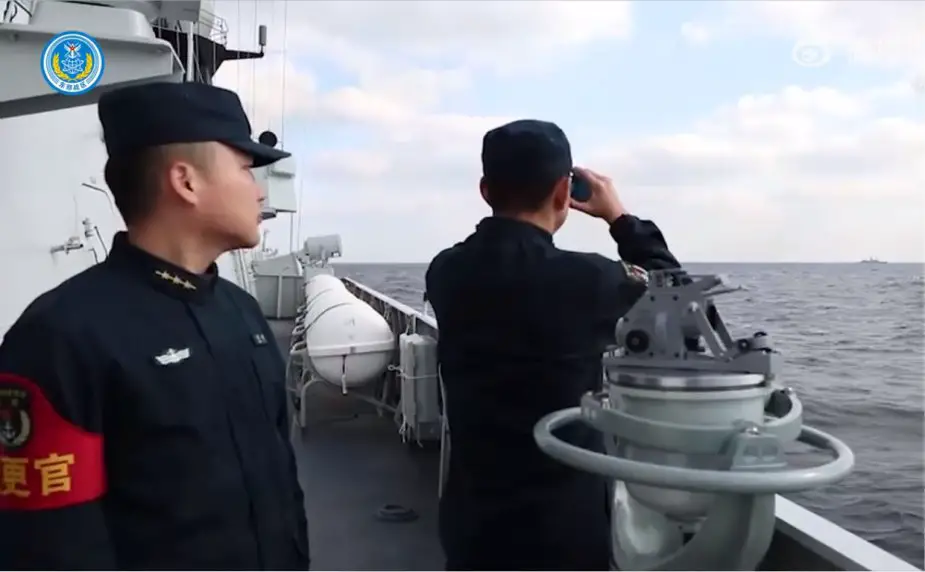Analysis: What are the scenarios for China's takeover of Taiwan?
According to information published by the Chinese MoD on December 25, 2022, the PLA Eastern Theater Command conducted the joint combat-readiness security patrol and joint firepower striking exercise involving troops of multiple services and arms in the waters and airspace around Taiwan Island. Let's imagine the scenarios of an attempt by China to take over the island in the years to come.
Follow Navy Recognition on Google News at this link
 Chinese sailors on PLA Navy's Type 052C destroyer during the exercise. (Picture source: Weibo account of the PLA Eastern Theater Command)
Chinese sailors on PLA Navy's Type 052C destroyer during the exercise. (Picture source: Weibo account of the PLA Eastern Theater Command)
According to a report published by the Brooking Institution, Beijing considers Taiwan an integral part of Chinese territory that must be reunified with the mainland. The previous commander of U.S. Indo-Pacific Command thinks China may try to settle the issue with force, perhaps even within the next five years or so.
But can China conquer Taiwan?
Regardless of the type of contingency, it is clear that China has many strengths today that it did not 70 years ago, and therefore, no one should consider the risks of any contingency to be modest or the likely gains predictable.
Chinese thinkers seem increasingly confident that the U.S.-China military balance is shifting in their favor. In the last half-decade, Chinese grand strategists appear to have settled on a more ambitious and expansive vision for the nation — to broaden its influence not only in the western Pacific but also well beyond.
As noted earlier, the analysis here focuses on two overarching scenarios of a blockade contingency, the second of which could likely follow the first. Here is a more detailed overview of each one:
• Scenario 1: A maritime fight centered on submarines.
• Scenario 2: A broader subregional war.
Beyond a maritime blockade, other types of contingencies, such as an invasion of Taiwan, deserve analysis and attention, too. But they are less likely to occur.
In an amphibious invasion, Beijing would probably have to make some very fraught moves, such as preemptively attacking U.S. aircraft carriers and land bases in the broader western Pacific region to prevent the United States from launching aircraft that seek to attack troop-laden assault ships.
SCENARIO #1: SUBMARINE AND ANTISUBMARINE WARFARE OPERATIONS AT SEA
This scenario is built on the notion that China would use its submarine force and any mines it could deploy near Taiwan — but not other, more visible and vulnerable assets — to threaten commercial shipping to and from Taiwan and to challenge any naval forces that might seek to break the blockade.
It assumes that China would be willing to risk its entire inventory of some 60 submarines (40 being quite modern and quiet and 20 less so) in the effort. It further assumes that, to hedge its bets and present as complex a threat environment as possible, China would arm 20 of the submarines with torpedoes and the other 40 with anti-ship missiles.
SCENARIO #2: EXPANDED WAR, INCLUDING MISSILE STRIKES AND AIR RAIDS
Scenario two still maintains certain thresholds or firebreaks against escalation. But it enlarges the battle to include the use of Chinese landbased missiles against Okinawa, Guam, and Taiwan, as well as U.S. and allied ships if China can find them.
It also includes a massive air raid by China against any ships it can find near Taiwan, once it has damaged runways and otherwise hampered the operations of landbased aircraft. The scenario also encompasses American/allied attacks against military facilities in southeastern China.
CONCLUSION
Any attempt to predict with confidence the likely winner of a war waged over a Chinese blockade of Taiwan seems bound to fail. The outcome of such a war is, as argued here, profoundly unpredictable.
The results suggest that should China attempt to strangle Taiwan, the United States should think more creatively and asymmetrically rather than launch an all-out blockade-busting effort. The United States might instead consider a concept of warfare centered on a multinational boycott and embargo on trade with China.
In the years ahead, both sides will try to change the current correlation of forces in and around the Taiwan Strait to their advantage. The analysis here suggests that relative vulnerabilities in C4ISR systems would be the most important determinants of a blockade contingency, and, as such, they warrant the greatest relative prioritization for future investment.
But whatever the various parties attempt, the profound unpredictability of any blockade contingency will be difficult to alter. Too many factors contribute to C4ISR fragility, and they will be very difficult to mitigate.


























